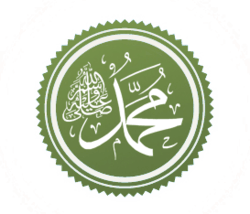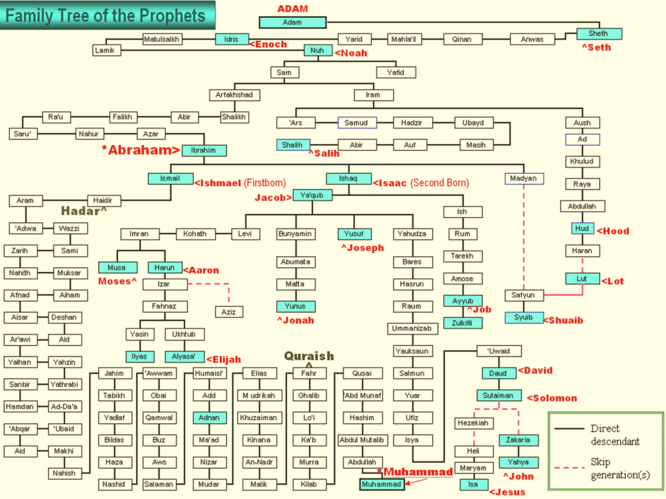Family tree of Muhammad
This family tree is about the relatives of the Islamic prophet Muhammad known as a family member of the family of Hashim and the Qurayshs tribe which is ‘Adnani.[1][2][3][4]
Family tree
| Kilab ibn Murrah | Fatimah bint Sa'd | ||||||||||||||||||||||||||||||||||||||||||||||
| Zuhrah ibn Kilab (progenitor of Banu Zuhrah) maternal great-great-grandfather | Qusai ibn Kilab paternal great-great-great-grandfather | Hubba bint Hulail paternal great-great-great-grandmother | |||||||||||||||||||||||||||||||||||||||||||||
| `Abd Manaf ibn Zuhrah maternal great-grandfather | `Abd Manaf ibn Qusai paternal great-great-grandfather | Atikah bint Murrah paternal great-great-grandmother | |||||||||||||||||||||||||||||||||||||||||||||
| Wahb ibn `Abd Manaf maternal grandfather | Hashim ibn 'Abd Manaf (progenitor of Banu Hashim) paternal great-grandfather | Salma bint `Amr paternal great-grandmother | |||||||||||||||||||||||||||||||||||||||||||||
| Fatimah bint `Amr paternal grandmother | `Abdul-Muttalib paternal grandfather | Halah bint Wuhayb paternal step-grandmother | |||||||||||||||||||||||||||||||||||||||||||||
| Aminah mother | `Abdullah father | Az-Zubayr paternal uncle | Harith paternal half-uncle | Hamza paternal half-uncle | |||||||||||||||||||||||||||||||||||||||||||
| Thuwaybah first nurse | Halimah second nurse | Abu Talib paternal uncle | `Abbas paternal half-uncle | Abu Lahab paternal half-uncle | 6 other sons and 6 daughters | ||||||||||||||||||||||||||||||||||||||||||
| Muhammad | Khadija first wife | `Abd Allah ibn `Abbas paternal cousin | |||||||||||||||||||||||||||||||||||||||||||||
| Fatimah daughter | Ali paternal cousin and son-in-law family tree, descendants | Qasim son | `Abd-Allah son | ||||||||||||||||||||||||||||||||||||||||||||
| Zainab daughter | Ruqayyah daughter | Uthman second cousin and son-in-law family tree | Umm Kulthum daughter | Zayd adopted son | |||||||||||||||||||||||||||||||||||||||||||
| Ali ibn Zainab grandson | Umamah bint Zainab granddaughter | `Abd-Allah ibn Uthman grandson | Rayhana bint Zayd wife | Usama ibn Zayd adoptive grandson | |||||||||||||||||||||||||||||||||||||||||||
| Muhsin ibn Ali grandson | Hasan ibn Ali grandson | Husayn ibn Ali grandson family tree | Umm Kulthum bint Ali granddaughter | Zaynab bint Ali granddaughter | Safiyya tenth wife | ||||||||||||||||||||||||||||||||||||||||||
| Abu Bakr father-in-law family tree | Sawda third wife | Umar father-in-law family tree | Umm Salama sixth wife | Juwayriya eighth wife | Maymuna eleventh wife | ||||||||||||||||||||||||||||||||||||||||||
| Aisha third wife Family tree | {{{Zaynab bint Khuzaymah}}} | Hafsa fourth wife | Zaynab seventh wife | Umm Habiba ninth wife | Maria al-Qibtiyya twelfth wife | ||||||||||||||||||||||||||||||||||||||||||
| Ibrahim son | |||||||||||||||||||||||||||||||||||||||||||||||
- * indicates that the marriage order is disputed
- Note that direct lineage is marked in bold.
Genealogy
| Part of a series on |
| Muhammad |
|---|
 |
|
Views |
|
Related |
|
Wathilah ibn al-Asqa narrated that Muhammad said;
"Indeed Allah chose Isma'il from the progeny of Ibrahim, chose the Banu Kinanah over other tribes from the children of Isma'il; He chose the Banu Quraish over other tribes of Kinanah; He chose Banu Hashim over the other families of the Quraish; and He chose me from Banu Hashim."
— Related by Muslim and Tirmidhi.
Muhammad to Adnan
According to Islamic prophetic tradition, Muhammad was descended from Adnan. Tradition records the genealogy from Adnan to Muhammad comprises 21 generations. "The following is the list of chiefs who are said to have ruled the Hejaz and to have been the patrilineal ancestors of Muhammad."[4]

- 570 CE – Muhammad
- 545 CE – Abdullah
- 497 CE – Shaybah (Abd al-Muttalib)
- 464 CE – Hashim
- 439 CE – Abd Manaf
- 406 CE – Qusayy
- 373 CE – Kilab
- 340 CE – Murrah
- 307 CE – Ka'b
- 274 CE – Lu'ayy
- 241 CE – Ghalib
- 208 CE – Fihr
- 175 CE – Malik
- 142 CE – An-Nadr (Quraysh)[5]
- 109 CE – Kinanah
- 76 CE – Khuzaimah
- 43 CE – Mudrikah
- 10 CE – Ilyas
- 23 BCE – Mudar
- 56 BCE – Nizar
- 89 BCE – Ma'add
- 122 BCE – Adnan
Adnan to Isma'il
Various genealogies of Adnan up to Isma'il have been narrated. Adnan was the ancestor of the Adnani Arabs of northern, central and western Arabia and a direct descendant of Isma'il. It is not confirmed how many generations are between them; however, Adnan was fairly close to Isma'il. Isma'il had twelve sons who are said to have become twelve tribal chiefs throughout the regions from Havilah to Shur (from Assyria to the border of Egypt).
Genealogists differ from which son of Isma'il the main line of descent came, either through his eldest son Nabut, or his second son Qedar who was the father of the North Arabian Qedarite tribe that controlled the region between the Persian Gulf and the Sinai Peninsula. Genealogists also differ in the names on the line of descent.
Muhammad ibn Jarir al-Tabari states:
"The genealogists do not differ concerning the descent of our Prophet Muhammad as far as Ma’add b. ‘Adnan."
— The History of al-Tabari, Volume 6, p. 37

Ibrahim to Nuh
`Abd Allah ibn `Abbas narrated Muhammad said;
"The descendants of `Imran, mentioned in Allah's saying, ‘Allah did choose Adam and Nuh, the family of Ibrahim, and the family of `Imran above all people,-' [Quran 03:33] are the believers among sons of Ibrahim, `Imran, Yasin and Muhammad"
— Related by Bukhari.
"And We sent Noah and Abraham, and established in their line Prophethood and Revelation: and some of them were on right guidance. But many of them became rebellious transgressors."
— Qur'an, chapter 57 (Al-Hadid), verse 26.
It is unclear how many generations are between Ibrahim and Nuh. Nuh's son Sam was the ancestor of the Semitic race.
| Lineage of several prophets according to Islamic tradition |
|---|
| Dotted lines indicate multiple generations |
Nuh to Adam
'Abd Allah ibn 'Abbas narrated Muhammad said;
“Between Nuh and Adam were ten generations, all of them were upon Sharia of the truth, then they differed. So Allah sent prophets as bringers of good news and as warners.”
— Related by Hakim al-Nishaburi in Al-Mustadrak alaa al-Sahihain.
Family tree linking Prophets to Shi'ite Imams
| Family tree linking prophets to Imams | |||||||||||||||||||||||||||||||||||||||||||||||||||||||||||||||||||||||||||||||||||||||||||||||||||||||||||||||||||||||||||||||||||||||||||||||||||||||||||||||||||||||||||||||||||||||||||||||||||||||||||||||||||||||||||||||||||||||||||||||||||||||||||||||||||||||||||||||||||||||||||||||||||||||||||||||||||||||||||||||||||||||||||||||||||||||||||||||||||||||||||||||||||||||||||||||||||||||||||||||||||||||||||||||||||||||||||||||||||||||||||||||||||||||||||||||||||||||||||||||||||||||||||||||||||||||||||||||||||||||||||||||||||||||||||||||||||||||||||||||||||||||||||||||||||||||||||||||||||||||||||||||||||||||||||||||||||||||||||||||||||||||||||||||||||||||||||||||||||||||||||||||||||||||||||||||||||||||||||||||||||||||||||||||||||||||||||||||||||||||||||||||||||||||||||||||||||||||||||||||||||||||||||||||||||||||||||||||||||||||||||||||||||||||||||||||||||||||||||||||||||||||||||||||||||||||||||||||||||||||||||||||||||||||||||||||||||||||||||||||||||||||||||||||||||||||||||||||||||||||
|---|---|---|---|---|---|---|---|---|---|---|---|---|---|---|---|---|---|---|---|---|---|---|---|---|---|---|---|---|---|---|---|---|---|---|---|---|---|---|---|---|---|---|---|---|---|---|---|---|---|---|---|---|---|---|---|---|---|---|---|---|---|---|---|---|---|---|---|---|---|---|---|---|---|---|---|---|---|---|---|---|---|---|---|---|---|---|---|---|---|---|---|---|---|---|---|---|---|---|---|---|---|---|---|---|---|---|---|---|---|---|---|---|---|---|---|---|---|---|---|---|---|---|---|---|---|---|---|---|---|---|---|---|---|---|---|---|---|---|---|---|---|---|---|---|---|---|---|---|---|---|---|---|---|---|---|---|---|---|---|---|---|---|---|---|---|---|---|---|---|---|---|---|---|---|---|---|---|---|---|---|---|---|---|---|---|---|---|---|---|---|---|---|---|---|---|---|---|---|---|---|---|---|---|---|---|---|---|---|---|---|---|---|---|---|---|---|---|---|---|---|---|---|---|---|---|---|---|---|---|---|---|---|---|---|---|---|---|---|---|---|---|---|---|---|---|---|---|---|---|---|---|---|---|---|---|---|---|---|---|---|---|---|---|---|---|---|---|---|---|---|---|---|---|---|---|---|---|---|---|---|---|---|---|---|---|---|---|---|---|---|---|---|---|---|---|---|---|---|---|---|---|---|---|---|---|---|---|---|---|---|---|---|---|---|---|---|---|---|---|---|---|---|---|---|---|---|---|---|---|---|---|---|---|---|---|---|---|---|---|---|---|---|---|---|---|---|---|---|---|---|---|---|---|---|---|---|---|---|---|---|---|---|---|---|---|---|---|---|---|---|---|---|---|---|---|---|---|---|---|---|---|---|---|---|---|---|---|---|---|---|---|---|---|---|---|---|---|---|---|---|---|---|---|---|---|---|---|---|---|---|---|---|---|---|---|---|---|---|---|---|---|---|---|---|---|---|---|---|---|---|---|---|---|---|---|---|---|---|---|---|---|---|---|---|---|---|---|---|---|---|---|---|---|---|---|---|---|---|---|---|---|---|---|---|---|---|---|---|---|---|---|---|---|---|---|---|---|---|---|---|---|---|---|---|---|---|---|---|---|---|---|---|---|---|---|---|---|---|---|---|---|---|---|---|---|---|---|---|---|---|---|---|---|---|---|---|---|---|---|---|---|---|---|---|---|---|---|---|---|---|---|---|---|---|---|---|---|---|---|---|---|---|---|---|---|---|---|---|---|---|---|---|---|---|---|---|---|---|---|---|---|---|---|---|---|---|---|---|---|---|---|---|---|---|---|---|---|---|---|---|---|---|---|---|---|---|---|---|---|---|---|---|---|---|---|---|---|---|---|---|---|---|---|---|---|---|---|---|---|---|---|---|---|---|---|---|---|---|---|---|---|---|---|---|---|---|---|---|---|---|---|---|---|---|---|---|---|---|---|---|---|---|---|---|---|---|---|---|---|---|---|---|---|---|---|---|---|---|---|---|---|---|---|---|---|---|---|---|---|---|---|---|---|---|---|---|---|---|---|---|---|---|---|---|---|---|---|---|---|---|---|---|---|---|---|---|---|---|---|---|---|---|---|---|---|---|---|---|---|---|---|---|---|---|---|---|---|---|---|---|---|---|---|---|---|---|---|---|---|---|---|---|---|---|---|---|---|---|---|---|---|---|---|---|---|---|---|---|---|---|---|---|---|---|---|---|---|---|---|---|---|---|---|---|---|---|---|---|---|---|---|---|---|---|---|---|---|---|---|---|---|---|---|---|---|---|---|---|---|---|---|---|---|---|---|---|---|---|---|---|---|---|---|---|---|---|---|---|---|---|---|---|---|---|---|---|---|---|---|---|---|---|---|---|---|---|---|---|---|---|---|---|---|---|---|---|---|---|---|---|---|---|---|---|---|---|---|---|---|---|---|---|---|---|---|---|---|---|---|---|---|---|---|---|---|---|---|---|---|---|---|---|---|---|---|---|---|---|---|---|---|---|---|---|---|---|---|---|---|---|---|---|---|---|---|---|---|---|---|---|---|---|---|---|---|---|---|---|---|---|---|---|---|---|---|---|---|---|---|---|---|---|---|---|---|---|---|---|---|---|---|---|---|---|---|---|---|---|---|---|---|---|---|---|---|---|---|---|---|---|---|---|---|---|---|---|---|---|---|---|---|---|---|---|---|---|---|---|---|---|---|---|---|---|---|---|---|---|---|---|---|---|---|---|---|---|---|---|---|---|---|---|---|---|---|---|---|---|---|
| |||||||||||||||||||||||||||||||||||||||||||||||||||||||||||||||||||||||||||||||||||||||||||||||||||||||||||||||||||||||||||||||||||||||||||||||||||||||||||||||||||||||||||||||||||||||||||||||||||||||||||||||||||||||||||||||||||||||||||||||||||||||||||||||||||||||||||||||||||||||||||||||||||||||||||||||||||||||||||||||||||||||||||||||||||||||||||||||||||||||||||||||||||||||||||||||||||||||||||||||||||||||||||||||||||||||||||||||||||||||||||||||||||||||||||||||||||||||||||||||||||||||||||||||||||||||||||||||||||||||||||||||||||||||||||||||||||||||||||||||||||||||||||||||||||||||||||||||||||||||||||||||||||||||||||||||||||||||||||||||||||||||||||||||||||||||||||||||||||||||||||||||||||||||||||||||||||||||||||||||||||||||||||||||||||||||||||||||||||||||||||||||||||||||||||||||||||||||||||||||||||||||||||||||||||||||||||||||||||||||||||||||||||||||||||||||||||||||||||||||||||||||||||||||||||||||||||||||||||||||||||||||||||||||||||||||||||||||||||||||||||||||||||||||||||||||||||||||||||||||
Ancestry
| Ancestors of Muhammad | ||||||||||||||||||||||||||||||||||||||||||||||||||||||||||||||||||||||||||||||||||||||||||||||||||||||||||||||||||||||||||||||||||||||||||||||||||||||||||||||||||||||||||||||||||||||||||||||||||||||||||||||||||||||||||||||||||||||||||||||||||||||||||||||||||||||||||||||||||||||||||||||||||||||||||||||||||||||||||||||||||||||||||||||||||||||||||||||||||||||||||||||||||||||||||||||||||||||||||||||||||||||||||||||||||||||||||||||||||||||||||||||||||||||||||||||||||||||||||||||||||||||||||||||||||||||||||||||||||||||||||||||||||||||||||||||||||||||||||||||||||||||||||||||||||||||||||||||||
|---|---|---|---|---|---|---|---|---|---|---|---|---|---|---|---|---|---|---|---|---|---|---|---|---|---|---|---|---|---|---|---|---|---|---|---|---|---|---|---|---|---|---|---|---|---|---|---|---|---|---|---|---|---|---|---|---|---|---|---|---|---|---|---|---|---|---|---|---|---|---|---|---|---|---|---|---|---|---|---|---|---|---|---|---|---|---|---|---|---|---|---|---|---|---|---|---|---|---|---|---|---|---|---|---|---|---|---|---|---|---|---|---|---|---|---|---|---|---|---|---|---|---|---|---|---|---|---|---|---|---|---|---|---|---|---|---|---|---|---|---|---|---|---|---|---|---|---|---|---|---|---|---|---|---|---|---|---|---|---|---|---|---|---|---|---|---|---|---|---|---|---|---|---|---|---|---|---|---|---|---|---|---|---|---|---|---|---|---|---|---|---|---|---|---|---|---|---|---|---|---|---|---|---|---|---|---|---|---|---|---|---|---|---|---|---|---|---|---|---|---|---|---|---|---|---|---|---|---|---|---|---|---|---|---|---|---|---|---|---|---|---|---|---|---|---|---|---|---|---|---|---|---|---|---|---|---|---|---|---|---|---|---|---|---|---|---|---|---|---|---|---|---|---|---|---|---|---|---|---|---|---|---|---|---|---|---|---|---|---|---|---|---|---|---|---|---|---|---|---|---|---|---|---|---|---|---|---|---|---|---|---|---|---|---|---|---|---|---|---|---|---|---|---|---|---|---|---|---|---|---|---|---|---|---|---|---|---|---|---|---|---|---|---|---|---|---|---|---|---|---|---|---|---|---|---|---|---|---|---|---|---|---|---|---|---|---|---|---|---|---|---|---|---|---|---|---|---|---|---|---|---|---|---|---|---|---|---|---|---|---|---|---|---|---|---|---|---|---|---|---|---|---|---|---|---|---|---|---|---|---|---|---|---|---|---|---|---|---|---|---|---|---|---|---|---|---|---|---|---|---|---|---|---|---|---|---|---|---|---|---|---|---|---|---|---|---|---|---|---|---|---|---|---|---|---|---|---|---|---|---|---|---|---|---|---|---|---|---|---|---|---|---|---|---|---|---|---|---|---|---|---|---|---|---|---|---|---|---|---|---|---|---|---|---|---|---|---|---|---|---|---|---|---|---|---|---|---|---|---|---|---|---|---|---|---|---|---|---|---|---|---|---|---|---|---|---|---|---|---|---|---|---|---|---|---|---|---|---|---|---|---|---|---|---|---|---|---|---|---|---|---|---|---|---|---|---|---|---|---|---|---|---|---|---|---|---|---|---|---|---|---|---|---|---|---|---|---|---|---|---|---|---|---|---|---|---|---|---|---|---|---|---|
| ||||||||||||||||||||||||||||||||||||||||||||||||||||||||||||||||||||||||||||||||||||||||||||||||||||||||||||||||||||||||||||||||||||||||||||||||||||||||||||||||||||||||||||||||||||||||||||||||||||||||||||||||||||||||||||||||||||||||||||||||||||||||||||||||||||||||||||||||||||||||||||||||||||||||||||||||||||||||||||||||||||||||||||||||||||||||||||||||||||||||||||||||||||||||||||||||||||||||||||||||||||||||||||||||||||||||||||||||||||||||||||||||||||||||||||||||||||||||||||||||||||||||||||||||||||||||||||||||||||||||||||||||||||||||||||||||||||||||||||||||||||||||||||||||||||||||||||||||
See also
- Family tree of Shaiba ibn Hashim
- Abraham's Family Tree
- Ancestry of Qusai ibn Kilab
- Descent from Adnan to Muhammad
- Family tree of Ali
- Family tree of Husayn ibn Ali
- Ahl al-Bayt
- Banu Hashim
- Quraysh tribe
- Banu Kinanah
- Alid
- Hashemite
- Fatimid Caliphate
- Idrisid dynasty
- Alaouite dynasty
- Shi'a view of Ali
References
- Maqsood, Ruqaiyyah Waris. "The Prophet's Line Family No 3 – Qusayy, Hubbah, and Banu Nadr to Quraysh". Ruqaiyyah Waris Maqsood Dawah. Archived from the original on 2008-05-30. Retrieved 2013-07-01.
- Ibn Hisha=1. p. 181. Missing or empty
|title=(help) - Parolin, Gianluca P. (2009). Citizenship in the Arab World: Kin, Religion and Nation-State. p. 30. ISBN 978-9089640451. "The ‘arabicised or arabicising Arabs’, on the contrary, are believed to be the descendants of Ishmael through Adnan, but in this case the genealogy does not match the Biblical line exactly. The label ‘arabicised’ is due to the belief that Ishmael spoke Hebrew until he got to Mecca, where he married a Yemeni woman and learnt Arabic. Both genealogical lines go back to Sem, son of Noah, but only Adnanites can claim Abraham as their ascendant, and the lineage of Mohammed, the Seal of Prophets (khatim al-anbiya'), can therefore be traced back to Abraham. Contemporary historiography unveiled the lack of inner coherence of this genealogical system and demonstrated that it finds insufficient matching evidence; the distinction between Qahtanites and Adnanites is even believed to be a product of the Umayyad Age, when the war of factions (al-niza al-hizbi) was raging in the young Islamic Empire."
- Hughes, Thomas Patrick (1995) [First published 1885]. A Dictionary of Islam: Being a Cyclopaedia of the Doctrines, Rites, Ceremonies, and Customs, Together With the Technical and Theological Terms, of the Muhammadan Religion. New Delhi: Asian Educational Services. p. 19. ISBN 978-81-206-0672-2. Retrieved July 24, 2010.
- Koenig, Harold G. (2014-01-01). "Differences and Similarities". Health and Well-Being in Islamic Societies. Springer Science+Business Media. p. 97.
The Quraysh was Nadhr, the 12th tribal generation down from Kedar, the son of Ishmael mentioned in the Bible.
- Ibn Hisham, Rahmat-ul-lil'alameen, 2/14-17.
- Firestone et al., 2001, pp. 11–12. This list of names is based on the work of a 16th-century Syrian scholar. Alternate transliterations of the Arabic appear in parentheses. For those names that have articles, which use the most common English name, the article has been linked, but the name appears as transliterated from the Arabic.